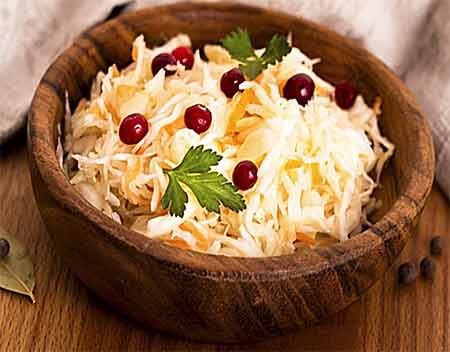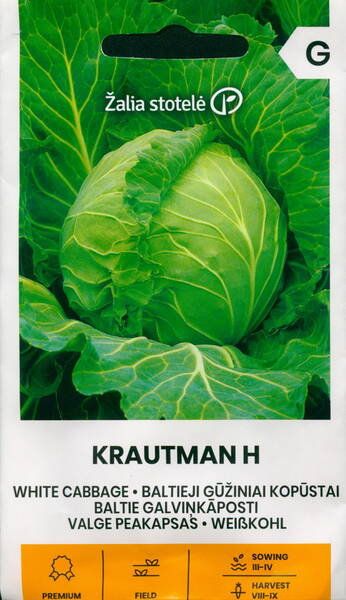Ex Tax: 1.75€
Simultaneous yield of the crop. The excellent taste.
Medium late hybrid (from planting seedlings to harvesting 100-105 days, from sowing to harvesting 120-140 days).
A head of cabbage weighing 3,5-6 kg, slightly affected by mucous bacteriosis, resistant to cracking. The rosette is compact, the leaves are half-raised. Planting pattern: 60 cm x 45 cm. Productivity - up to 9 kg / m2.
This hybrid is perfect for fermentation. By the way, it is no less good in fresh salads!
Please note that ... the harmonious yield of the Krautman F1 hybrid allows you to harvest cabbage as soon as possible. Heads of cabbage are resistant to cracking, aligned in shape and size, which makes it possible to obtain marketable products not only for their own consumption, but also for sale.
The special value of the Krautman F1 hybrid is its very dense, excellent-tasting heads of cabbage, suitable for fresh consumption and for fermentation.
1,0 g = 250-300 seeds.

* RULES FOR STORING SAUERKRAUT.
Sauerkraut is best stored at a temperature of about 0 ° C. In this case, the cabbage mass in the container should be covered with brine on top. This is necessary because vitamin C is destroyed very quickly in fermented cabbage without brine. It should be removed from the brine in small portions, if possible immediately before eating - lying in a room or refrigerator in a "dry" state, it will cease to be so useful. In a barrel or tub, the remaining cabbage is leveled, again closed with a lid and the load is returned to its place.
It is advisable to sprinkle sauerkraut from time to time on top with one spoonful of granulated sugar - the sugar under the influence of microorganisms turns into vinegar, which protects the cabbage from spoilage. Certain berries added to it, especially lingonberries and cranberries, lengthen the shelf life of sauerkraut well. Mustard powder, which contains a natural antiseptic, allyl oil, is a good means of fighting mold that appears on the surface of the brine.
Although by itself it does not lose its properties at lower temperatures, thawing sauerkraut and subsequent freezing leads to a complete loss of vitamin C and some other valuable chemical compounds. Therefore, it should be eaten immediately after the first thawing, and if this is not possible (for example, there is too much of it), then it is better to avoid freezing at all.
The best recipe.
For 10 kg of cabbage: 200-250 g of salt, 500 g of carrots (grated on a coarse grater), 1 celery root, 1 kg of whole or chopped apples or 100-200 g of lingonberries, cranberries.
Mix chopped cabbage with carrots, celery, apples and salt. For even salting, it is better to place the cabbage in a wider container and stand for 0.5-1 hour. Then put in a bucket (saucepan or jars), firmly sealing to remove air, cover with whole cabbage leaves, with a clean cloth and press down with oppression.
To remove unpleasant gases, you need to pierce the cabbage to the bottom with a sharp, smooth stick until the release of gases stops. After 15-20 days, depending on the room temperature, the cabbage will be ready. It is laid out in 3-liter jars and put into a refrigerator or cellar.
10 secrets of sauerkraut cabbage.
Is there a more useful edible plant than cabbage, loved by everyone, especially in sauerkraut. All good housewives ferment cabbage, but it does not always work out ...
Several secrets of its preparation:
1. Use only white, firm heads of mid to late maturing varieties.
2. Delicious cabbage is obtained only in wooden barrels or in enameled dishes.
3. Be sure to remove the top green and damaged leaves, remove the stump - it gives bitterness.
4. It is important to finely chop or chop the head of cabbage, and cut the carrots into thin slices or grate on a coarse grater. The more carrots, the tastier and more beautiful the cabbage is.
5. Salt must be rock and non-iodized. It is important not to oversalt the cabbage! Salt is added to taste.
6. At the bottom of the container, do not forget to put slices of black bread, wrapped in cabbage leaves. But the bread should be tasty and aromatic.
7. Antonov apples give a special charm to cabbage! Cranberries or lingonberries are also added to cabbage.
8. Do not grind cabbage with salt - it will not be crispy. Cabbage mixed with carrots and salt is laid in layers (10 cm) and tamped with a fist or wooden crush until the juice is released. The first (bitter) juice should drain, so the cabbage is placed in a container with a slide and covered with a wooden circle with oppression (10% of the total mass of the fermented cabbage).
9. The first 2-3 days the cabbage is kept for fermentation at a temperature of +18 .. + 20 ° C. To improve the taste and aroma, it is pierced daily (to the bottom) with a sharpened wooden stick. The resulting foam is removed.
10. For 10 kg of cabbage you need: salt - 100-150 g, carrots and apples - 1 kg each, cranberries or lingonberries - 200-250 g.












